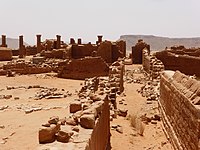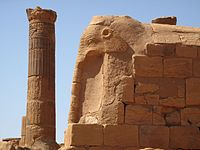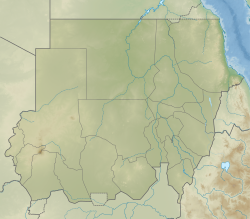Musawwarat es-Sufra
المصورات الصفراء | |
 Apedemak Lion Temple | |
 Shown within Northeast Africa | |
| Alternative name | Musawwarat es-Sufra |
|---|---|
| Location | Musawwarat es-Sufra, River Nile (state), Sudan |
| Region | Nubia |
| Coordinates | 16°24′57″N 33°19′25″E / 16.41583°N 33.32361°ECoordinates: 16°24′57″N 33°19′25″E / 16.41583°N 33.32361°E |
| Type | Sanctuary |
| Official name | Archaeological sites of the Island of Meroe |
| Type | Cultural |
| Criteria | ii, iii, iv, v |
| Designated | 2011 (35th session) |
| Reference no. | 1336 |
| Region | Arab States |
Musawwarat es-Sufra (Arabic:المصورات الصفراء al-Musawwarāt as-sufrā, Meroitic: Aborepi, Old Egyptian: jbrp, jpbr-ˁnḫ), also known as Al-Musawarat Al-Sufra, is a large Meroitic temple complex in modern Sudan, dating back to the early Meroitic period of the 3rd century BC.[1] It is located in a large basin surrounded by low sandstone hills in the western Butana, 180 km northeast of Khartoum, 20 km north of Naqa and approximately 25 km south-east of the Nile. Its MGRS coordinates: 36QWD3477214671. With Meroë and Naqa it is known as the Island of Meroe, and was listed as a UNESCO World Heritage Site in 2011.[2] Constructed in sandstone, the main features of the site include the Great Enclosure, the Lion Temple of Apedemak and the Great Reservoir. Most significant is the number of representations of elephants, suggesting that this animal played an important role at Musawwarat es-Sufra.
Research[]
The site of Musawwarat es-Sufra was originally mentioned by Linant de Bellefonds in 1822, and then shortly thereafter by Frédéric Cailliaud. The first detailed description of the site was made by Carl Richard Lepsius. Archaeological fieldwork was conducted by the Butana expedition of the Humboldt University of Berlin under the direction of archaeologist Fritz Hintze from 1960 until 1970. The team re-erected the Lion Temple, collapsed in antiquity, and constructed a new roof. These investigations continued after a gap of several decades and are ongoing.[3]
Lion Temple[]
The Lion Temple is a single-chambered rectangular 14.21 m in length, 9.13 m in width and 4.7 m in height temple with pylon and six columns made of drums. Erected by King Arnekhamani and dedicated to Apedemak the temple bears inscriptions in Egyptian hieroglyphs and representations of elephants and lions on the rear inside wall as well as reliefs of Apedemak depicted as a three-headed god on the outside walls.[4] A 3D model of the Lion Temple can be seen here. An Animation of the Lion Temple 3D model can be view here.

Columns in the Lion Temple

Stamp: A file of elephants leading prisoners

Relief of Apedemak
Great Enclosure[]
The Great Enclosure is the main structure of the site. Much of the large labyrinth-like building complex, which covers approximately 45,000 m2, was erected in the third century BC.[5] According to Hintze, "the complicated ground plan of this extensive complex of buildings is without parallel in the entire Nile valley".[6] The maze of courtyards includes three (possible) temples, passages, low walls, preventing any contact with the outside world, about 20 columns, ramps and two reservoirs.[7][8]
There were many sculptures of animals, such as elephants and most of the walls of the complex bear graffiti and masons’ or pilgrims' marks both pictorial and in Meroitic or Greek script.[9] The scheme of the site is, so far, without parallel in Nubia and ancient Egypt, and there is some debate about the purpose of the buildings, with earlier suggestions including a college, a hospital, and an elephant-training camp.[3] According to the scholar Basil Davidson, at least four Kushite queens — Amanirenas, Amanishakheto, Nawidemak and Amanitore — probably spent part of their lives in Musawwarat es-Sufra.[10]

View of the Great Enclosure

An entrance to the Great Enclosure

Statue of an elephant

Wall-drawing

Graffiti of Prince Pückler-Muskau
Great Reservoir[]

The Great Reservoir is a Hafir to retain as much as possible of the rainfall of the short, wet season. It is 250 m in diameter and excavated 6.3 m into the ground.[11]
3D Models with laser-scanning[]
The Zamani Project document cultural heritage sites in 3D to create a record for future generations.[12][13][14][15] The documentation of the Great Enclosure of Musawwarat es-Sufra and the Apedemak (Lion) Temple is based on terrestrial laser-scanning [16][17] and was carried out in 2009.[18] 3D models, animations, plans and images of some of the temples are online available at www.zamaniproject.org
References[]
- ^ www.musawwarat.com/chronology
- ^ UNESCO Island of Meroe.
- ^ Jump up to: a b UNESCO Nomination document p.43.
- ^ Gilda Ferrandino and Matteo Lorenzini; 3D Reconstruction of the Lion Temple at Musawwarat es Sufra: 3D model and domain ontologies; in: The Kushite World (2015). Proceedings of the 11th International Conference for Meroitic Studies;Vienna, 1–4 September 2008.
- ^ The Great Enclosure
- ^ Hintze, Fritz (1978). The Kingdom of Kush: The Meroitic Period. The Brooklyn Museum. pp. 89–93.
- ^ Zamani Project
- ^ Google Books Sudan: The Bradt Travel Guide p.131-2.
- ^ Graffiti of the Great Enclosure
- ^ Basil Davidson, Old Africa Rediscovered, Prentice-Hall 1970.
- ^ Claudia Näser; The Great Hafir at Musawwarat as-Sufra. Fieldwork of the Archaeological Mission of Humboldt University Berlin in 2005 and 2006. On: Between the Cataracts. Proceedings of the 11th Conference of Nubian Studies. Warsaw University, 27 August - 2 September 2006; In: Polish Centre of Mediterranean Archaeology University of Warsaw. PAM Supplement Series 2.2./1-2.
- ^ Rüther, Heinz; Rajan, Rahim S. (2007). "Documenting African Sites: The Aluka Project". Journal of the Society of Architectural Historians. 66 (4): 437–443. doi:10.1525/jsah.2007.66.4.437. ISSN 0037-9808. JSTOR 10.1525/jsah.2007.66.4.437.
- ^ Rüther, Heinz. "AN AFRICAN HERITAGE DATABASE – THE VIRTUAL PRESERVATION OF AFRICA'S PAST" (PDF). isprs.org.
- ^ Giles, Chris. "Meet the scientists immortalizing African heritage in virtual reality". CNN. Retrieved 2019-10-17.
- ^ Wild, Sarah. "Africa's great heritage sites are being mapped out with point precision lasers". Quartz Africa. Retrieved 2019-10-17.
- ^ Rüther, Heinz; Held, Christof; Bhurtha, Roshan; Schroeder, Ralph; Wessels, Stephen (2012-01-13). "From Point Cloud to Textured Model, the Zamani Laser Scanning Pipeline in Heritage Documentation". South African Journal of Geomatics. 1 (1): 44–59–59. ISSN 2225-8531.
- ^ "Challenges in Heritage Documentation with Terrestrial Laser Scanning" (PDF).
- ^ "Site - Temple Complex - Musawwarat es Sufra". zamaniproject.org. Retrieved 2019-10-30.
Literature[]
- Basil Davidson Old Africa Rediscovered, Gollancz, 1959
- Peter Shinnie Meroe, 1967
External links[]
| Wikimedia Commons has media related to Musawwarat es-Sufra. |
- The Musawwarat graffiti archive
- www.musawwarat.com Archaeological Mission to Musawwarat es-Sufra: Project website with basic information and current publications
- Ancient Sudan Meroe Gallery
- Youtube 3D fly through
- Documentary film on archaeological research and conservation at Musawwarat es-Sufra by Humboldt University, Berlin
- Kingdom of Kush
- History of Nubia
- African civilizations
- Archaeological sites in Sudan
- World Heritage Sites in Sudan









